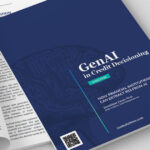As a companion to our 2015: Year in Review post, we’ve synthesized some of the trends, challenges and opportunities shaping the financial industry in 2016. This year’s predictions include topics from the preceding year, with the addition of projected advancements in the areas of biometrics, enhanced customer experience, big data, digital payments, and innovation.
Biometrics
Stemming from the rise of mobile, biometric identification protocols will become the norm to prevent identity theft and fraudulent activity on financial services platforms.
Information gathered from a Deloitte report states, “72% of consumers would appreciate the use of biometric identification in banking (which includes fingerprints and/or iris recognition) for device authentication in financial services transactions.
Right now, the main biometric identification in use is fingerprint. However, iris and facial recognition technologies are beginning to surface as viable options as well.
Customer Experience: Eliminating Friction
The digital movement is affecting all industries, especially banking. The advent of mobile resulted in a hyper-connected customer base, providing access to their financial institutions (FIs) through an array of devices and channels. Technology provides instant gratification, so the customer expects to be able to research their options, access their accounts, and resolve issues anytime, anywhere. If banks fail to provide services tailored to the desires of the customer, friction begins to diminish customer trust and loyalty.
According to Don Peppers, founder of Peppers & Rogers Group, “The best kind of experience a customer can have is one in which he can meet his need or solve his problem completely effortlessly, without having to jump through hoops or overcome obstacles.”
Engaged customers become advocates for their FIs, leading to increased referrals that in turn, spur the growth of the bank. It will be interesting to see how banks continue the transition to a more customer-centric approach in 2016.
EMV Transition
While point of sale (POS) liability for EMV became official in October 2015, ATM compliance for MasterCard won’t take effect until October 2016; for Visa that shift will come in October 2017. Automated fuel dispensers are also exempt from EMV compliance until October 2017.
Adding more confusion to the narrative, the majority of vendors that have the proper POS terminals have yet to activate them. Retailers that are accepting EMV cards are struggling to provide a seamless checkout experience for customers – lack of employee training, longer transaction times, and equipment hiccups further alienated consumers from the EMV process. Ironically, this could lead to contactless payments becoming a more attractive option via mobile phone.
The EMV transition in the U.S. was by far the most talked about payments-related story of 2015. The changeover is an ongoing process that will continue to impact the industry in the coming year.
Cloud Computing
The advantage of transitioning to cloud technology is two-fold. It will reduce IT costs, while allowing banks the flexibility to keep up with new technological advancements.
Gartner, a technology consulting firm, believes more than 60% of banks across the globe will transition to processing payments via the cloud by the end of 2016. Historically, the idea of cloud computing has been suppressed due to intense regulatory and security concerns. However, with dwindling profits and the demand to slash IT spending, FIs are warming up to the notion of using cloud services.
Implementing Big Data
The financial industry, as a whole, manages more data than any other business sector due to the sheer amount of transactions. IT system technologies have progressed and evolved in recent years to better manage this enormous amount of data. The creation of data mining tools enables FIs to better organize and utilize information that provides insight into customer tendencies to further eliminate risk.
A recent study procured by CapGemini Consulting revealed that roughly 60% of FIs in North America believe analytics provides an advantage over other companies. Furthermore, roughly 90% were adamant that focusing on data mining will “determine the winners of the future.”
Blockchain
Security in the financial industry is vital for all parties involved. Blockchain, known to some as bitcoin, is a technology that cryptographically secures networks and assets that eliminates third-party mediators. In essence, blockchain is a decentralized ledger that monitors transactions in an effort to reduce corruption. This also enables FIs to work around their sometimes inefficient legacy systems and take a more streamlined, secure route.
There are rumblings revolving around the idea of banks implementing blockchain within the next year. The upside to FIs using blockchain technology is potentially limitless, but implementation will be incredibly slow.
Fintechs: Collaboration or Competition?
Initially, and understandably so, banks were concerned about whether or not fintechs would disrupt the financial industry. To this point, the argument could go either way, but it appears FIs want to collaborate with these entities rather than outright compete. Fintechs are agile, contemporary, and possess technology that customers find appealing. Customers trust their bank with their money but expect their bank to adapt to their specific needs.
If combined, there is opportunity to exist harmoniously; both have a unique skill-set that the other can benefit from. In 2016, partnerships may ultimately lead to banks providing the tools and services that customers have come to expect.
What is your take on where the financial industry is headed in 2016? Please share your predictions with us.





